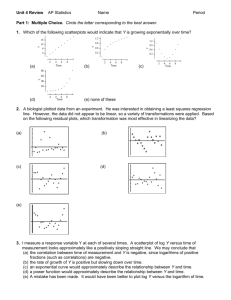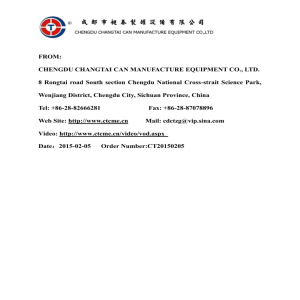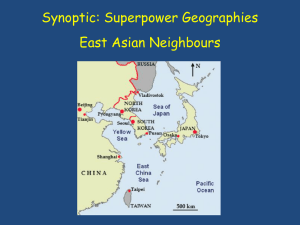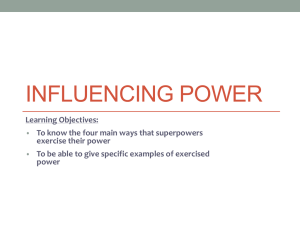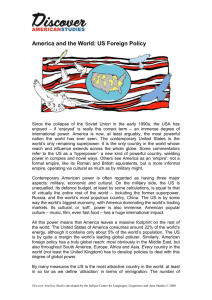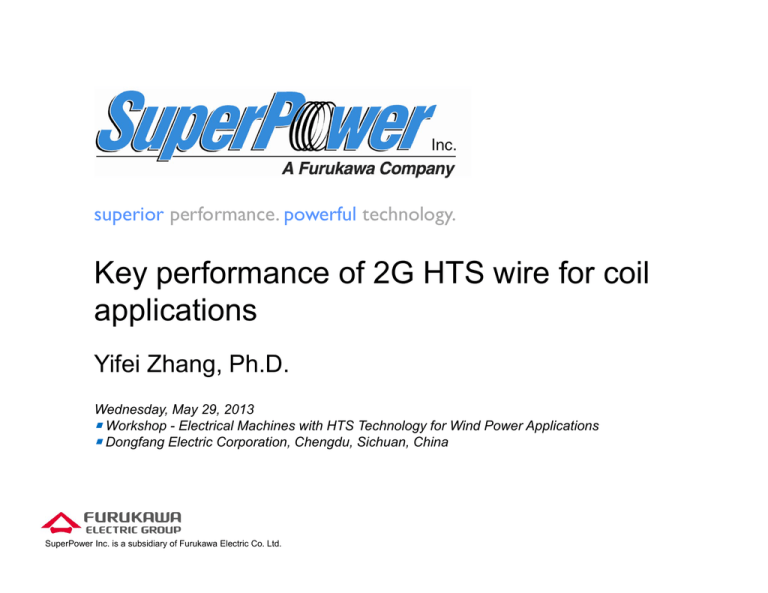
superior performance. powerful technology.
Key performance of 2G HTS wire for coil
applications
Yifei Zhang, Ph.D.
Wednesday, May 29, 2013
Workshop - Electrical Machines with HTS Technology for Wind Power Applications
Dongfang Electric Corporation, Chengdu, Sichuan, China
SuperPower Inc. is a subsidiary of Furukawa Electric Co. Ltd.
Acknowledgements
• Special thanks to my colleagues at SuperPower for their contributions
–
–
–
–
–
–
–
–
D. W. Hazelton
H. Song
P. Brownsey
T. Fukushima
A. R. Knoll
L. V. Hope
H. Sakamoto
R. B. McClure
All Rights Reserved. Copyright SuperPower® Inc. 2013
Wind Power Workshop DEC, Chengdu 5/29/2013
2
Outline
•
•
•
SuperPower Inc. - company profile
Wire architecture, manufacturing, and specification
Wire performance - important to coil applications
– in-field performance
– mechanical strength
– splice resistance and strength
•
•
Making reliable coils
Summary
All Rights Reserved. Copyright SuperPower® Inc. 2013
Wind Power Workshop DEC, Chengdu 5/29/2013
3
SuperPower Inc. formed in 2000 to develop and
produce 2G HTS wire
• Intermagnetics (IGC) spins off from GE in 1971
– Supplying LTS magnets for highly successful MRI business (Philips
Electronics and others)
• Early focus on HTS begins at IGC in 1987
– Development of first generation (1G) HTS (BSCCO) wire
– Early device demonstrations (transformer, fault current controller) with 1G
wire
– Realization of superiority of 2G HTS materials – first to transition
• Multiple factors predict enormous market potential for 2G HTS-based
electric power systems: increasing demand, aging infrastructure,
deregulation
All Rights Reserved. Copyright SuperPower® Inc. 2013
Wind Power Workshop DEC, Chengdu 5/29/2013
4
2006-2012 The Philips years
•
•
IGC acquired by Philips Electronics in 2006 for MRI magnet business
Six years to build value – leading supplier of 2G HTS wire
–
–
–
–
•
Buildup of strong R&D, manufacturing, and marketing team
R&D focusing on wire performance improvements
Strategic Research Agreement with the Univ. of Houston – TcSUH
Transition to pilot-scale manufacturing
Market and customer oriented
– Exploration of wide range of commercial markets – energy focus and beyond
– Buildup of broad global customer base
All Rights Reserved. Copyright SuperPower® Inc. 2013
Wind Power Workshop DEC, Chengdu 5/29/2013
5
A new strategic owner steps up
•
Furukawa Electric acquired SuperPower in February 2012
– Adding the world leader in 2G HTS to Furukawa’s long history in LTS
– Focus on long-term sustainability in an evolving market
– Concentration on continuous manufacturing improvements over
established baseline capabilities
– Steady expansion of production capacity to meet market requirements
All Rights Reserved. Copyright SuperPower® Inc. 2013
Wind Power Workshop DEC, Chengdu 5/29/2013
6
Architecture of SuperPower’s 2G HTS wire
• Substrate (Hastelloy®
C-276) provides
mechanical strength,
electropolished
surface for
subsequent layer
growth
• IBAD-MgO provides
template for growing
epitaxial buffer layers
• Buffer layers provide:
– Diffusion barrier
between substrate
and REBCO
– Lattice match with
REBCO
All Rights Reserved. Copyright SuperPower® Inc. 2013
• REBCO layer – optimized composition with
nanosized BZO & RE2O3 flux pinning sites for high
in-field Ic at all field orientations
• Ag layer – provides good current transfer to HTS
layer and facilitates oxygen diffusion during
oxygenation annealing
• Cu layer – provides stabilization (parallel path for
current) during operation and quench conditions
Wind Power Workshop DEC, Chengdu 5/29/2013
7
2G HTS wire manufacturing at SuperPower
•
•
•
•
Automated processes, in-situ material characterization
Reel-to-reel systems
High throughput, fast processes
Modular and scalable systems
Substrate electro-polishing
All Rights Reserved. Copyright SuperPower® Inc. 2013
IBAD-MgO
Wind Power Workshop DEC, Chengdu 5/29/2013
REBCO layer MOCVD
8
2G HTS wire manufacturing at SuperPower
•
Quality assurance throughout processes
•
Rigorous testing, product certification with
each delivery
•
Continuous improvement in processing
and wire performance
•
Technical support to customers
Transport Ic measurement
Slitting
All Rights Reserved. Copyright SuperPower® Inc. 2013
Insulation
Wind Power Workshop DEC, Chengdu 5/29/2013
9
2G HTS standard wire specifications
• “SCS” – Surrounded Copper Stabilizer’; “SF” – Stabilizer Free
• Two chemical formulations:
– AP (Advanced Pinning) – for enhanced in-field performance for coil
applications in motors, generators, SMES, high-field magnets, etc.
– CF (Cable Formulation) – for cable and SFCL
•
Variations in width, substrate thickness, stabilizer thickness, and
insulation
– Insulated wire: polyimide tape wrapped - 30% overlap or butt-wrap
All Rights Reserved. Copyright SuperPower® Inc. 2013
Wind Power Workshop DEC, Chengdu 5/29/2013
10
•
•
All Rights Reserved. Copyright SuperPower® Inc. 2013
LHe
LH2 LNe
NbTi Nb3Sn
LN2 LO2
MgB2
YBCO Bi2223
Bi2212
80
NbTi
Nb3Sn
MgB2
Bi2212
Bi2223
YBCO
60
40
20
0
•
Much larger application potential
lies beyond the capability of LTS
wires, as well as MgB2 and
BSCCO wires
Wide range of coil applications
including generators & motors,
SMES, flywheels, maglev,
accelerators, insert magnets,
transformers, MRI & NMR,
induction heaters, bearings, etc.
Requires sophisticated,
engineered and cost-effective
wires
Requires performance in many
aspects – electrical, mechanical,
thermal, etc.
Birr (Tesla)
•
100 120
2G HTS wire – a broad range of applications
0
20
40
60
80
100
120
Temperature (K)
Adapted from B. Jensen et al.
J. Renewable & Sustainable Energy
Vol. 5, 023137 (2013)
Wind Power Workshop DEC, Chengdu 5/29/2013
11
Wire performance important to coil applications
•
•
•
•
•
Ic(B, T, θ)
– engineering current density
– field dependence
– field orientation dependence
– minimum Ic(θ)
Electromechanical properties (mechanical strength)
– axial tensile (irreversible stress or strain limits)
– transverse (c-axis) tensile (along tape surface normal)
– transverse (c-axis) compressive (along tape surface normal)
– transverse compressive (along width)
– bending (with REBCO under compression or tension)
– fatigue (in various stress states)
Uniformity along length (Ic and other attributes)
Quench stability
Splice
– geometry
– resistance (resistivity)
– mechanical strength (tensile and bending)
Standards for 2G HTS wire characterization and testing are under development
All Rights Reserved. Copyright SuperPower® Inc. 2013
Wind Power Workshop DEC, Chengdu 5/29/2013
12
IEC Standards on Superconductivity (TC90)
(17 Publications, None on 2G HTS wire at this time)
All Rights Reserved. Copyright SuperPower® Inc. 2013
Wind Power Workshop DEC, Chengdu 5/29/2013
13
In-field performance - key to coil applications
4.2 K
14 K
22 K
33 K
45 K
50 K
65 K
77 K
Ic (B//c, T) / Ic (self field, 77 K)
10.00
Motors,
generators
SMES
1.00
0.10
Cables, FCLs,
transformers
0.01
0.0
2.0
4.0
6.0
8.0
10.0
12.0
14.0
16.0
Applied Field B (T)
Ic(B,T)/Ic(self field, 77K) defined as Lift Factor
All Rights Reserved. Copyright SuperPower® Inc. 2013
Wind Power Workshop DEC, Chengdu 5/29/2013
14
Lift factor of production wire
Lift Factor (2.5T, 30K, H//ab) = 5.6
Lift Factor (2.5T, 30K, H//c) = 2.6
All Rights Reserved. Copyright SuperPower® Inc. 2013
Wind Power Workshop DEC, Chengdu 5/29/2013
15
Magnetic field orientation dependence of Jc (Ic)
• Results from electronic anisotropy
and structural anisotropy
• Important to coil design
• Critical current density (Jc) given
by force balance when
pinning force = Lorentz force
• Nanoscale defects needed
especially in the direction parallel
to the c-axis to enhance flux
pinning
• Zr doping effective to improve Jc
for H//c
H⊥I
b
a
All Rights Reserved. Copyright SuperPower® Inc. 2013
Wind Power Workshop DEC, Chengdu 5/29/2013
16
Flux pinning enhancement via nanostructure
engineering
• Techniques to introduce nanoscale defects
into REBCO layer
• Tailoring precursor composition (Zr content,
RE substitution, RE:Ba:Cu ratio)
• Optimized MOCVD deposition condition for
the growth of nanostructure
• BaZrO3 and RE2O3 nanorods and
nanoparticles
• Controlled density, size, orientation &
distribution
• Targeted wire performance for different
applications (field and temperature)
• Zr doping results in significant
enhancement in flux pinning for H//c,
raising minimum Ic
• RE2O3 helps maintain high peak at H//a-b
All Rights Reserved. Copyright SuperPower® Inc. 2013
Wind Power Workshop DEC, Chengdu 5/29/2013
17
ARPA-E REACT Program
- further improvement in in-field/low-T performance
(Rare Earth Alternatives for Critical Technologies)
• Develop high performance, low-cost superconducting wires and coils for wind
turbine generators that are lighter, more powerful, and more efficient
• Partnering between university, institution, and companies
– University of Houston – project lead, wire improvements
– SuperPower – wire manufacturer
– NREL (National Renewable Energy Laboratory) – impact evaluation of
enhanced superconducting wire on overall system performance
– Tai Yang Research Company – coil fabrication and test
– TECO Westinghouse Motor Company – device design
• Goal: four-fold improvement in lift factor (2.5T, 30K)
• Project started in January 2012
• Program period: 3 years
• Budget: $3.1 million
All Rights Reserved. Copyright SuperPower® Inc. 2013
Wind Power Workshop DEC, Chengdu 5/29/2013
18
Ic (A, 77K, s.f.) and n-value
Ic uniformity along length
(four-probe transport measurement)
Position (m) (on a 4 mm wide wire)
All Rights Reserved. Copyright SuperPower® Inc. 2013
Wind Power Workshop DEC, Chengdu 5/29/2013
19
Ic uniformity along length (TapeStar)
Position (cm) (on a 12 mm wide wire)
•
•
•
•
Magnetic, non-contact measurement
High spacial resolution, high speed, reel-to-reel
Monitoring Ic at multiple production points after MOCVD
Capability of quantitative 2D uniformity inspection
All Rights Reserved. Copyright SuperPower® Inc. 2013
Wind Power Workshop DEC, Chengdu 5/29/2013
20
Mechanical strength of superconducting wires
•
•
•
•
•
Longitudinal (axial) direction – static tensile, cyclic tensile
Transverse direction (perpendicular to the surfaces) - static tensile, static
compressive, cyclic tensile
Transverse direction (parallel to the surfaces) – static compressive
Peeling – complex and concentrated stress
Bending – REBCO under tensile or compressive
800
transverse direction
SP 2G HTS
High Je
longitudinal direction
Stress (MPa)
600
400
High Strength
1G HTS Low Je
200
peeling
Nb3Sn
Moderate Je
Low Strength
1G HTSModerate Je
0
0
0.1
0.2
0.3
0.4
0.5
Strain (% )
All Rights Reserved. Copyright SuperPower® Inc. 2013
Wind Power Workshop DEC, Chengdu 5/29/2013
21
Tensile strength of 2G HTS wire
•
•
•
•
Stress-strain relationship under axial tensile load (at room temperature
or operating temperature)
- Basic mechanical behavior
Electro-mechanical performance: effect of stress (strain) on Ic
- Ic measurement after applying stress at RT, compared with zerostress critical current, Ic(0)
- Ic measurement while applying stress at a cryogenic temperature,
e.g., 77K, compared with zero-stress critical current, Ic(0)
- Ic measurement after applying stress at a cryogenic temperature,
e.g., 77K
- Increase stress level while applying a constant current, e.g., at 95%
of the zero-stress critical current, Ic(0)
Tensile stress (strain) limit: critical stress (strain) above which Ic drops
below 95% of the zero-stress critical current, Ic(0)
Tensile strength predominantly determined by the Hastelloy substrate,
but affected by the copper stabilizer thickness
All Rights Reserved. Copyright SuperPower® Inc. 2013
Wind Power Workshop DEC, Chengdu 5/29/2013
22
Tensile strength at room temperature
Effect of copper stabilizer thickness on stress-strain relationship at tension
All Rights Reserved. Copyright SuperPower® Inc. 2013
Wind Power Workshop DEC, Chengdu 5/29/2013
23
Tensile strength - effect of stress on Ic
Relative Ic vs. room temperature tensile stress for a 12mm wide
wire with 100μm Cu stabilizer
All Rights Reserved. Copyright SuperPower® Inc. 2013
Wind Power Workshop DEC, Chengdu 5/29/2013
24
Tensile strength at 4K and 77K
- Effect of copper stabilizer thickness
1200
Copper thickness
40 µm
1000
60 µm
stress (MPa)
800
600
100 µm
4 K and 77 K
400
data from NHMFL
200
0
0.000
0.002
0.004
0.006
0.008
0.010
0.012
strain
All Rights Reserved. Copyright SuperPower® Inc. 2013
Wind Power Workshop DEC, Chengdu 5/29/2013
25
Bending test to determine minimum bending
diameter
Compression
Tension
77K
Relative Ic vs. bending diameter for a 12mm wide wire with 100μm Cu
All Rights Reserved. Copyright SuperPower® Inc. 2013
Wind Power Workshop DEC, Chengdu 5/29/2013
26
Transverse compression perpendicular to surface
77K
• Compression at room temperature, Ic tested at 77 K
• No measurable degradation in critical current
All Rights Reserved. Copyright SuperPower® Inc. 2013
Wind Power Workshop DEC, Chengdu 5/29/2013
27
Transverse (c-axis) tensile strength
•
•
•
•
Stress builds up during coil winding, cooling, operation (mechanical,
thermal, and magnetic) with tensile components perpendicular to wire
surface
Transverse (c-axis) tensile stress (more complicatedly, the peel stress, or
cleavage stress) could cause wire delamination (either cohesive or
adhesive)
Various testing methods have been developed for the evaluation of wire
strength against delamination
- Anvil Test (NIST, SP, SRL-ISTEC, NHMFL w/Ic)
- Pin-Pull Test (SP)
- Stud-Pull Test (Fujikura)
- Cleavage Test (RIKEN w/Ic)
- Peel Test (SP)
- Four Points Bending Test (SRL-ISTEC)
- Double Cantilever Beam (DCB) Test (Kyoto University)
Delamination behavior affected by mechanical properties of individual layers
and the interfacial adhesion strength between adjacent layers
All Rights Reserved. Copyright SuperPower® Inc. 2013
Wind Power Workshop DEC, Chengdu 5/29/2013
28
Peel strength – strength against delamination
P
β
•
•
•
T-peel test
P
90° peel test
All Rights Reserved. Copyright SuperPower® Inc. 2013
Peeling Load (N)
•
Peel test at various peeling angles (change in
stress state at peeling tip), including 90°, 180°
peel, or T-peel
Peeling load vs displacement curve used for
determination of peel strength (N/cm)
Peeled surfaces analyzed for identifying
weakest layer or interface
Wire processing modification/optimization to
achieve higher peel strength
Displacement (mm)
Wind Power Workshop DEC, Chengdu 5/29/2013
29
Weakest layer (interface) varies with stress state
180° peel test
90° peel test
Optical images of peeled surfaces
All Rights Reserved. Copyright SuperPower® Inc. 2013
Wind Power Workshop DEC, Chengdu 5/29/2013
30
Peel strength – strength against delamination
•
Relationship observed between peel strength measured at different
peeling angles, e.g., ps(90°)=0.56ps(T)+0.3
All Rights Reserved. Copyright SuperPower® Inc. 2013
Wind Power Workshop DEC, Chengdu 5/29/2013
31
Reliable splices – low resistance and high strength
•
•
•
•
•
•
•
•
•
Splicing always required by real
applications
Splice properties are important
conductor performance and have
influences on dielectrics and
cryogenics as well
Low resistance and high
electromechanical strength are
basic requirements
Contact resistivity at REBCO/Ag interface has an effect on splice resistance
Splices fabricated via soldering at a temperature below 250°C
Soldering temperature, pressure, duration time are important parameters
Ic retained across the splices with no degradation through soldering
Splice resistance R ≤ 20 nΩ and minimum bending diameter d ≈ 25 mm, for the
lap joint geometry with a 10cm overlap length
Splicing per customer request and each splice inspected
All Rights Reserved. Copyright SuperPower® Inc. 2013
Wind Power Workshop DEC, Chengdu 5/29/2013
32
Splice resistance vs. overlap length
160
1, 147
1, 147
140
1, 132
120
Resistance (nOhm)
100
2, 83.3
2, 76.6
80
2, 63.6
60
4, 36.1
4, 37.8
4, 34
40
20
6, 25.1
8, 17.9
6, 21.7
8, 17.7
8, 17.4 10, 15.7
10, 14.8
10, 15.610, 14.3
0
0
2
4
10, 27.2
6, 23.3
6
8
10
11.5, 14.1
11.5, 14.1
11.5, 13
12
14
Splice Length (cm)
All Rights Reserved. Copyright SuperPower® Inc. 2013
Wind Power Workshop DEC, Chengdu 5/29/2013
33
Making reliable coils using 2G HTS wire
- coil winding techniques investigated
Epoxy
Epoxy has strong effect on coil performance
Support
Thermal coefficient consideration
KIT, RTRI
Siemens
Former
Release
Insulation
Co-winding
Winding
Tension
Improvement found in coil stability
Alternative materials – stress relaxation &
cooling
NHMFL, RIKEN
Improved integrity and stability
NHMFL, MIT, BNL
Compactness and integrity
Mitigate stress and improve integrity & stability
All Rights Reserved. Copyright SuperPower® Inc. 2013
Wind Power Workshop DEC, Chengdu 5/29/2013
34
Metal strip co-winding for high field magnet has
been effectively used by many groups
•
•
•
•
•
1995, MIT/Sumitomo, SS co-winding, 1G HTS Bi2223
– Generation of 24.0 T at 4.2 K and 23.4 T at 27 K with a high-temperature
superconductor coil in a 22.54 T background field
• APL, 67, 1923, 1995
2003, NHMFL/OST, co-wind SS (28 μm), 1G HTS Bi2212
– Development of a 5T HTS Insert Magnet as Part of 25T Class Magnets
• IEEE Trans. Appl. Supercond., 13 (2), 1396, 2003
2011, MIT/FBML, co-wind Cu (0.2 mm with one side polyester) for REBCO, co-wind
SS (50 um) for Bi-2223
– A 1.3 GHz LTS/HTS NMR magnet – a progress report
• IEEE Trans. Appl. Supercond., 21 (3), 2092, 2011
2011, BNL, co-wind SS or Kapton (25 μm), 2G HTS REBCO
– High field HTS R&D solenoid for Muon Collider
• IEEE Trans. Appl. Supercond., 21 (3), 1884, 2011
2012, NHMFL, plain co-wind SS, 2G HTS REBCO
– Design of a Superconducting 32 T magnet with REBCO high field coils
• IEEE Trans. Appl. Supercond., 22 (3), 4300704, 2012
All Rights Reserved. Copyright SuperPower® Inc. 2013
Wind Power Workshop DEC, Chengdu 5/29/2013
35
SS co-winding and partial epoxy winding
•
•
•
SS co-winding benefits
– Mechanical reinforcement
– Less contained epoxy, improvement w/r to cool-down
– Insulation may become stabilizer during transient/local quench
– Increased thermal conductivity, compared to conventional insulation
SS co-winding impacts
– Ramping loss (low ramping rate, HTS larger thermal margin)
– Current re-distribution during quench (may need modeling for large
magnet)
– Impact on current density
Partial epoxy impregnation offers positive results
– Side applied, epoxy partially penetrated into turns, 30-40% of epoxy
coverage for 4 mm wide wire
– Seals the coil, protects it from moisture
– Mechanically fixes turn-turn and layer-layer
All Rights Reserved. Copyright SuperPower® Inc. 2013
Wind Power Workshop DEC, Chengdu 5/29/2013
36
Summary
•
2G HTS wire provides advantages with higher current density and
superior in-field performance for various coil applications
•
SuperPower’s 2G HTS wire production grows steadily, meeting
performance and volume requirements from different customers
•
In-field performance (lift factor) and mechanical strength are among the
key properties important to coil applications and being further improved
with continuous R&D efforts
•
Government-funded application development projects (e.g., SMES, FCL
Transformer, and Wind Turbine Generator) are being pursued to
demonstrate the technology and speed the adoption
For more information: http://www.superpower-inc.com
For questions: yzhang@superpower-inc.com
All Rights Reserved. Copyright SuperPower® Inc. 2013
Wind Power Workshop DEC, Chengdu 5/29/2013
37

